How To Upload .dat Data Eeglab
8 Import Data
Import-Data
A new generalized data import mechanism we call Data Connectors was added in Origin 2019b. As the proper name implies, Data Connectors create a link between your project and an external source file. The source file may be local, information technology tin can be on a company network; it can even exist on a web-server. Data Connectors support options for excluding imported data when saving the project (smaller files, plus, maintain a live link to source data) and for protection of data confronting accidental alteration or deletion. Data Connectors also brand possible import of previously-unavailable data sources, including HTML Tables and JavaScript Object Notation (JSON). Data Connectors support drag-and-drop and Car Import on Projection Open up. In addition, OriginLab continues to aggrandize Connector support to new data formats. In Origin 2021b, for instance, we accept improved Connectors for National Instruments TDMS and NetCDF files; plus we've added a new Thermo Fisher Scientific MSRawFile Connector.
Other supported import mechanisms:
- OriginLab continues support for Origin's long-standing 10-Function + filter-based routines for ASCII, CSV, Excel, binary files, and many third-party formats, including MATLAB, pClamp, NI TDM and NetCDF. If y'all are a long-time user and you take import filters and Themes that you have long relied on, they should still piece of work as they always have.
- Copy-paste for quick import of simply-structured data (mostly useful for quickly adding data to worksheets).
- For complex ASCII, binary or User-divers file types, you can utilise the graphical interface of the Import Magician to parse your file and save settings to an import filter file. The Import Wizard supports power features such equally saving file metadata to variables and use of custom Origin C functions for data processing and import.
- If yous piece of work with SQL databases, you can use Origin's Database Connector and SQL Editor interface to create connection strings and SQL queries.
Contents
- one A Note to Upgrade Users
- ii Data Connectors
- 2.1 Things to Know nearly Data Connectors
- 2.2 Data Source File Path
- ii.3 Data Navigator
- ii.4 Information Connectors and Drag-and-Drop
- iii Connecting to Text/CSV
- 4 Connecting to MATLAB Files
- 5 Connecting to NetCDF and Shapefiles
- half dozen Connecting to a Deject Drive
- 7 Working with Excel Data
- 7.ane Connecting to Excel Files
- 8 Import from File
- 8.1 Importing ASCII Files with impASC
- eight.two Saving Import Settings
- 8.3 Third Party Formats
- 9 The Import Wizard
- 10 Re-create/Paste the Clipboard Data
- xi Selectively Import Data by Querying an Origin File
- 12 Database
- 13 Digitizer
- 14 Saving Origin Files without Imported Data
- 15 Re-Importing Data Files
- 16 Clone Import
- 17 Topics for Further Reading
A Note to Upgrade Users
Longtime Origin users who are upgrading from older versions should notation that import routines take moved from the File menu to a new Data menu. Hither, you will also find Origin'south newest data-import tool: Data Connectors.
Data Connectors
Data Connectors are a general machinery for importing information to your Origin projects from local or from web-based files and pages. Data Connectors differ from older Origin import methods primarily in two default (but modifiable) behaviors:
- Data imported via Connector is locked to editing. This helps ensure data integrity.
- Data imported via Connector is non saved with the projection. This helps to keep your project files smaller.
Data Connectors support a number of common information formats, including:
- Text/CSV
- Excel
- MATLAB
- Origin File (project, workbook, matrix)
- HTML Table
- JavaScript Object Notation (JSON)
- HDF
- TDMS
- NetCDF
- N42
- Import Filter (use a custom import filter with the Data Connector mechanism)
| | To connect to SQL database, see Database. |
To import information with a Data Connector:
- With your workbook active, click the Data carte.
-
- If you are connecting to a local or network file, click Connect to File and option a file blazon.
- To connect to multiple files, click Connect Multiple Files.
- If you are connecting to spider web data, click Connect to Web and enter a URL.
Things to Know about Information Connectors
- By default, when import information file size exceeds 500kB, the imported information and graphs made from that data are NOT saved with the Origin file (come across LabTalk system variable @FSE). All analysis output resulting from imported information ARE saved with the Origin file. Not saving raw data with your project file can significantly reduce file size and improve functioning when working with big projects.
- IMPORTANT: Since, by default, connector-imported data (> 500kB) is not saved with the project file, users should always ask themselves whether they need to preserve imported data. This could exist an issue when the data source is spider web-based and stored in a place beyond your control. If you prefer to salve all information imported via a Data Connector, with your Origin file, click the Data Connector icon and clear the check mark beside Exclude Imported When Saving prior to saving your file † . Note that each Information Connector-containing book will take its own Exclude... cheque mark. Alternately, if you make up one's mind the Information Connectors are non needed, you lot can click the Data Connector icon and choose Remove Data Connector (from this book) or Remove Information Connectors from All Books (in the project).
- Data can be re-imported at whatever fourth dimension by clicking the Data Connector icon (
 or
or  ) in the upper left corner of the worksheet and choosing Import (Ctrl+4) or Import All.
) in the upper left corner of the worksheet and choosing Import (Ctrl+4) or Import All. - By default, imported via a Data Connector is locked from editing. You tin can graph information technology and analyze information technology but you lot cannot change it. While this ensures confronting accidental modification, some users may find this also restrictive. Unlock sheet information by clicking the Connector icon and choosing Unlock Imported Data. See this FAQ for more than information on removing editing restrictions from Connector-imported data.
- A workbook can have only ane type of Connector (e.g. Text/CSV). For files with a elementary structure such as Text/CSV, you can take multiple sheets with each connecting to a separate file, as long as they share the same Connector. For files with more complex structures such as Excel or MATALAB, yous will initially connect to 1 canvass/variable, then utilize the Data Navigator's Add and Connect Canvass(southward) shortcut menu command to add together other sheets/variables in the book, as needed. You can only connect a single Excel or MATLAB file to a single Origin workbook or matrixbook.
- In books containing files with a simple construction (east.g. CSV), when you lot right-clicking on a sheet tab and add a new sail, the sheet is added with an empty Connector. The unconnected country is denoted by a pale-yellowish Connector icon
 (see Connector states, below). Click on the Connector icon to open up a shortcut carte where you can connect the sheet to a data source.
(see Connector states, below). Click on the Connector icon to open up a shortcut carte where you can connect the sheet to a data source.
- Information Connectors that you lot do not utilise tin can be hidden past choosing Data: Connect to File: Customize... and immigration the checkbox next to unused Connectors.
- Data Connectors for file formats not shipped with Origin, are available past clicking Data: Connect to File: Add New.... New Data Connectors are added to the Data menu.
| | † Origin caches information imported by Data: Connect to Spider web, for a period of time determined by LabTalk arrangement variable @CFDT, plus file size. Past default, a 10MB file will use cached data for ~24 hrs. In other words, if you lot re-import (i.e. reconnect to the web file) within 24 hrs, y'all volition be using data that was buried on commencement import. If you re-import to this 10MB file later on 24 hrs passes, the cache is cleared and the data are freshly imported. To learn how to control this caching beliefs see, these topics:
|
Data Source File Path
A Data Connector icon appears in one of five states:
Regardless of the state of the connexion, you lot can click the Connector icon, then employ the Data Source File Path and Mutual Information Path to assist you maintain the connection betwixt your Origin files and your source data.
- Relative to Project Path: If your data are stored in folders nether the project file, you could set Data Source File Path to Relative to Project path. Y'all tin and so move the project and data sources together, and their relative paths are preserved. No path corrections are and then needed when re-opening the project file from a different location on your network.
- Relative to Mutual Information Path: If data sources are under some common path, you could set Data Source File Path to Relative to Common Data Path. If the files are subsequently moved, you lot can re-establish the Mutual Information Path and then Import All Books.
Data Navigator
The Data Navigator is a collapsible panel that is automatically added to the workbook when you connect to multi-folio/multi-variable files such every bit Excel, MATLAB or Origin Projects.
- Origin volition import data from the commencement sheet and list other sheets in dimmed type.
- Right-click on a dimmed sail -- or printing CTRL or SHIFT and select multiple sheets -- then cull Add and Connect Sheets.
- The file proper name is assigned to the book Long Proper name and sheets are the original sheet name is assigned to sheet Proper name.
- Connected sheets tin can be deleted from the electric current Origin workbook.
Data Connectors and Drag-and-Drop
There is drag-and-drib support for the file types listed under Data: Connect to File:
- For files with a elementary header information (e.1000. only column name and units), a Data Connector is added and the file is properly parsed with no need for an import filter.
- For files that are not properly parsed (i.e. header information ends up in the data portion of the worksheet), consider making an Origin Import Filter (*.oif) file using the Import Sorcerer.
- Import filters can be saved to the data file folder, the User Files\Filters folder or in the current window. If you intend to employ a template for your information import, you tin save the filter to the window; otherwise the filter file (*.oif) should be placed either in the information file folder or in \User Files\Filters.
Connecting to Text/CSV
CSV Files
Y'all can employ a Data Connector to import local or web-stored text files (TXT, DAT, CSV). Data Connector methods work well for these file types, simplifying and in some cases eliminating, some of the issues associated with Origin's older 10-Function-based import routines. For instance, import of date-time data ever required transmission configuration of appointment-time columns. With Connectors, if your appointment-time data are of a standard, easily-recognized format, that configuration is done for you automatically.
To connect to a file on a local or LAN drive:
- With the workbook agile, choose Information: Connect to File: Text/CSV.
- Scan to and select your file.
- Fix your CSV Import Options. In many cases, you can but accept defaults and your file will be cleanly imported, so as a examination, attempt importing data without modifying defaults. If the results are unsatisfactory, rerun the import and modify the default settings.
| | In this mini-tutorial, we apply a Information Connector to import multiple files. These identically-structured files take multiple rows of metadata that nosotros want to preserve. And so, you volition make use of an import filter file that has been developed using the Import Wizard, to import the files and write file metadata out to multiple column label rows in each worksheet. In so doing, y'all volition see (a) how to import multiple files using a Data Connector and (b) how you tin can use an import filter file (*.oif) adult with an earlier version of Origin, to import files using Origin'south newer Data Connector technology.
|
To connect to a file on the Spider web:
- Choose Data: Connect to Web.
- If you accept a file URL, enter it in the URL box. Otherwise, set File Type to Text/CSV (optional merely helps to filter Contempo URLs), and then click directly on Recent URLs and selection from the list.
| | You tin utilize the CSV Import Options dialog to specify a partial import of spider web-stored files only equally you can for locally-stored files. Bank check the Partial Import box for guidance on the syntax used to define Column and Row import. |
Assistance: Origin: Origin Help > Text/CSV Connector
Connecting to MATLAB Files
While Origin continues to support older X-Function based MAT file import, Data Connectors offering some singled-out advantages for import of both locally-stored and web-stored MATLAB files:
- Connecting to a MATLAB file at the root level volition add all variables every bit Origin matrix objects in the matrixsheet.
- A slider is added and then that you tin flip through Origin matrix objects in the sheet. Y'all can toggle between slider and thumbnails using the Slider or Thumbnails Mini Toolbar push.
- The Connector also adds a collapsible Data Navigator panel to the window. If you wish to add variables as individual sheets, y'all tin can correct-click on the Data Navigator list and add together them.
To connect to a MATLAB file:
- With a workbook or matrixbook agile, click Data: Connect to File: MATLAB or Data: Connect to Spider web and enter a URL to your .mat file.
- Select the variables that you desire to import (add them to the Browser'due south bottom panel) and click OK.
Help: Origin: Origin Help > JSON/MATLAB
Connecting to NetCDF and Shapefiles
The NetCDF file format is used for sharing multi-dimensional scientific data. The format is widely used in climate scientific discipline. Shapefiles are commonly used to store geographic boundaries and other geo-spatial data.
To connect to a NetCDF file:
- With a workbook or matrixbook agile, click Data: Connect to File: NetCDF; or Data: Connect to Web and enter a URL to your .nc file.
- Select the variables that you want to import by adding them to the Browser's bottom panel.
- Adapt Import Options ("pencil" button) as needed and and click OK twice.
- If a workbook is active only the variable requires a matrixbook, you volition be prompted to add a new matrixbook or an embedded matrixbook in the active workook.
| | Origin 2022b improves .nc file import:
|
To connect to a Shapefile:
- With a workbook or matrixbook agile, click Data: Connect to File: Shapefile and scan to and choose your .shp file.
- Specify whether to Load Attributes and (optionally) encoding, and click OK.
Help: Origin: Origin Aid > NetCDF Connector
Connecting to a Cloud Drive
You lot tin connect to Origin, MS Excel and ASCII files stored on MS OneDrive or Google Drive. In one case you've established your business relationship credentials, connecting to cloud files is similar to connecting to local files:
- With a workbook active, click Data: Connect to Cloud. This opens the browser for picking files.
- Use the browser's drop-down controls to switch cloud services or accounts, if needed.
-
- Pick a file and click Open.
Annotation that the start time you connect to a cloud account, you'll be asked to verify that business relationship. OriginLab will only access and transfer data between your cloud business relationship and your local estimator using a temporary file. No other communication of information occurs.
Working with Excel Data
Excel There are several ways to work with MS Excel information in Origin:
- You can copy Excel data to the Clipboard and paste or paste link that data into Origin.
- You can utilise a Information Connector to import a local Excel file past (1) clicking Data: Connect to File: Excel, (ii) clicking the
 button on the Standard toolbar, or (3) dropping your Excel file onto the Origin workspace.
button on the Standard toolbar, or (3) dropping your Excel file onto the Origin workspace. - Yous can use a Data Connector to import Excel data from the spider web past clicking Information: Connect to Web: Excel (see below).
- You can use Origin'south older X-Part-based routines to import a local Excel file past clicking Information: Import From File. This choice was recently hidden to accommodate the Excel Connector simply if you prefer to use this method, see this department of the Origin Help file.
Things to know:
- Origin imports files of type .xls, .xlsx or .xlsm.
- If you are importing data using the Excel Connector, you can refresh your Origin-side data at any time by clicking the Connector icon
 and choosing Import; or re-import your Excel information at the time that you open the Excel-connected Origin project.
and choosing Import; or re-import your Excel information at the time that you open the Excel-connected Origin project. - If you lot are using the older (X-Role based) impMSExcel import routine: Sure file import information is saved to the workbook on import. Having one time imported an Excel file to an Origin workbook, you can use the Re-import button on the Standard toolbar to re-import an updated Excel file -- including those that contains multiple sheets -- to your Origin workbook.
- Origin does not support dynamically linking one Excel workbook with some other Excel workbook, nor does it recognize or interpret Excel formulas.
| | Both the Excel Connector and impMSExcel routines support partial import of Excel data. For more than information, see the Origin Assist file topic Partial Importing and Re-importing. |
Connecting to Excel Files
| | Origin 2022b auto detection of import file header info (i.e. column names, units and other file header information) is improved for Data: Connect to File: Excel. |
Origin'due south Data Connectors create a live link between your external data files and your Origin projection.
- To connect to a local file, click Data: Connect to File or click the
 button located on the Standard toolbar.
button located on the Standard toolbar. - To connect to a web-stored file, click Information: Connect to Web.
- You can connect ane Excel file per Origin workbook.
- If the file is a multi-sheet file, y'all must start connect to a unmarried sheet. This opens the the Information Navigator panel (described above) where you tin connect to additional pages, every bit needed.
- When all sheets are identically structured, ensuring that the kickoff sheet is properly parsed (e.g. the header information is correctly handled) will allow you to connect additional sheets without making adjustments.
Import from File
ASCII Information The import routines listed under Information: Import From File pre-engagement Data Connectors. While the Import From File routines are no longer being adult, they are still supported.
Note, too, that Connectors may non exist for some of the file types listed in this table. If no Data Connector exists, you should use the Information: Import From File methods.
| | The Standard toolbar Import Unmarried ASCII button |
Importing ASCII Files with impASC
- The Data: Import From File: Multiple ASCII... (
 ) method is by and large satisfactory for importing text files having a simple structure (works for unmarried or multi-file import). This routine will typically handle files with commonly-used delimiters and a simple header structure, without adjustments.
) method is by and large satisfactory for importing text files having a simple structure (works for unmarried or multi-file import). This routine will typically handle files with commonly-used delimiters and a simple header structure, without adjustments. - If the file import needs adjustments, select the Show Options Dialog checkbox when selecting your file(s) in the ASCII dialog. This will open the impASC dialog box prior to file import, assuasive you to tweak the way that the files are handled.
Saving Import Settings
Once you lot've adjusted impASC dialog import settings, you tin salve them in one of two means:
- With the worksheet template.
- As a Theme file from within the impASC dialog box (including saving for drag-and-drop).
Saving import settings with the worksheet template offers portability (e.k. templates are hands shared with colleagues). Saving import settings as a Theme offers the reward of being able to recall any number important options combinations (Themes) when importing via the impASC dialog box.
For more than information on Themes and templates, see the Customizing Origin affiliate afterwards in this User Guide. Additionally, see topics listed under "Topics for Further Reading", below.
| | You can rapidly load your custom import theme from the list at the bottom of the Data menu. You lot can also employ the Data: Import from File: Add/Remove File Types ... carte du jour to open the Import Carte du jour Customization dialog box where yous tin select and add User Themes to the Data: Import From File menu. |
Third Party Formats
If a Data Connector does non exist for a certain third-party format, you can still use Origin's older X-Function-based import routines. These include many widely-used formats, including pClamp, NI TDM, and NetCDF. As with all X-Function-based routines, y'all tin can customize third-party file import options and save your settings with the worksheet template or every bit a dialog Theme for later use. As with other supported file types, you can import tertiary party files by drag-and-drop. pClamp HDF5 SPC MATLAB JCAMP
| File Blazon | Method | To Learn More than, meet Help: Origin: Origin Help > Importing and Exporting Data |
|---|---|---|
| | Data: Import from File: | > Importing Third Political party Files |
Note: Some of these third party file formats are subconscious by default. To add, choose Data: Import From File: Add/Remove File Types.... This opens the Import Carte Customization dialog box where you can cull which file types to bear witness in the Import From File card. To insert a separator later a menu command, right-click on the command in the right-paw panel and cull Add together Separator. To remove a separator, double-click on it in the right-manus console.
Elevate-and-Drop, Importing by
| | If no Data Connector exists for a given file type (i.due east. those listed in the tabular array above), then drag-and-drop support is managed by file extension, using the Filter Manager dialog. From the main menu, click Preferences: Import Filters Manager.... |
Help: Origin: Origin Assist > Importing Tertiary Political party Files
The Import Wizard
For import of complex ASCII files -- those non satisfactorily handled by the methods previously discussed -- you lot can use the interactive Import Wizard. Files with an optional header section followed by a sequential binary structure, can also be imported using the Import Sorcerer:Binary Data Import Magician
Another reward to using the Import Wizard to your ASCII data is that yous tin can create import filters that are targeted to a group of similarly-named data files. This is particularly helpful when those files contain metadata that that needs to be handled in a certain way. The filter tin can then be used for drag-and-drib import operations and information technology can be added to the Data: Import From File carte.
| | A couple of improvements to Origin Import Filters (*.oif) for Origin 2022b:
|
To run the Import Magician:
- Choose Data: Import From File: Import Wizard... or click the
 push button located on the Standard toolbar.
push button located on the Standard toolbar.
- Develop Origin import filter files (*.oif) for import of ASCII files non handled satisfactorily past the Text/CSV Connector.
- Import data from the web pages using the Clipboard (see below).
- Extract variables from the import file proper name and header.
- Specify custom delimiters and date formats to parse your information.
- The ability to mail-process your imported data using a custom LabTalk script.
Help: Origin: Origin Help > Importing and Exporting Information > The Import Wizard
Copy/Paste the Clipboard Data
Clipboard Data, Importing I obvious style to get information into Origin is merely to copy data to the Clipboard and paste it into Origin. This can be as easy as selecting a block of data in an Excel workbook and pasting it into an Origin workbook. However, Clipboard data may non be formatted, arrayed or delimited in a way that makes it easy to paste your information into Origin. Here are some things y'all should know:
- Data copied from Excel and pasted to Origin volition be brought over with full precision, regardless of the number of displayed decimal digits in Excel.
- When working with Excel files with header information, paste the Clipboard information into data row 1 in Origin (not into the column label rows), then select a row and utilise the (right-click) shortcut key commands Fix every bit Long Name, Set as Units, Set as Annotate, etc. to tag your header information.
- Data copied from the web tin can be formatted in various ways. You may have to experiment a bit to find a method that brings the data over cleanly. If a simple re-create and paste doesn't work, endeavour using the Import Sorcerer. The Import Wizard provides an interactive interface for parsing Clipboard data, with the added benefit that you can save your procedure to an import filter file (.oif) for reuse with identically formatted information. For more data, run across the tutorial Using the Import Wizard to Import Clipboard Data.
Selectively Import Data by Querying an Origin File
Y'all can selectively import columns of data from an external Origin file past specifying an SQL-like Query in the Information Connector Browser prior to import.
To selectively query Origin files using the Origin Connector:
- With the worksheet active, choose Data: Connect to File or Connect to Web.
- Browse to your Origin file and click Open. This opens the Data Connector Browser.
- Click the Select Query push button
 .
. - Enter your Query in the Select Query dialog, and so click OK.
Data will be selectively imported into the active workbook every bit specified by your query.
Common Keywords:
| Keyword | Clarification |
|---|---|
| _SName | curt name, due east.g. _SName, Sheet_SName |
| _LName | long proper noun, due east.g. _LName, Book_LName |
| _Comments | comments, e.g. _Comments, Sheet_Comments |
| Column_D1 | cavalcade user-defined parameter, where 1 is the parameter index |
| Column_[Name] | column user-defined parameter, where [Name] is a parameter proper noun containing spaces |
Examples:
Select Column from Project where _SName == "A"; Select Column from Projection where _Comments similar "S*3"; Select Column from Projection where (Column_P1 like "*y*" and Column_D1 > iii ); Select Column from Project where Sheet_SName like "Trial*"; Select Column from Project where (Book_SName similar "Volume*" or Book_LName like "*fit*" )
For more information, see Examples of using SQL query condition in Origin Connector.
Database
SQL Data
Origin supports connecting to databases by ODBC and OLE DB. Additionally, Origin includes a simple SQL Editor to add connectedness strings and generate SQL queries within Origin.
To import SQL data, start with the Information: Connect to Database carte control:
- Open lets you lot scan for and open up a saved connection (ODS) or query (ODQ) file.
- New opens the Database Connector dialog.
-
- Connection string: Select this if you already take a text-based connection cord for a given data source (ODBC or OLE DB).
- ODBC data source: Select this if y'all have defined an ODBC data source via the WindowsODBC Data Source Ambassador applet.
- ODBC driver: Select this if you have an ODBC driver and desire to create a data source applicable to this information connector instance.
- Windows Data Link Backdrop dialog: Select this if y'all are using an OLE DB-based data source such as some SQL Server or Admission customer libraries.
-
Other things to note:
- Use the LabTalk organisation variable @IPDB to control protection of imported range (0 = no protection, i = protected but allow reorder, 2 = protected).
- Similar to other Connectors, yous can opt to Exclude Imported (information) When Saving as OPJU/OGWU.
Digitizer
Digitizing Scatter Plots At times, you lot may only have a graphic representation of some data that y'all would like to explore further. Employ the Digitizer to import an epitome file, then digitize the plots, converting your image to numeric data that y'all tin can report and re-plot using Origin'southward analysis and graphing tools.
- Import about common prototype formats.
- Rotate the imported image, remove noise and calibrate scales by picking start and cease values.
- Choice points on curves manually or automatically.
- Manually add curve inflection points, as needed.
- Interactively remove points that yous practice not want digitized.
- Support for Cartesian, polar and ternary coordinate systems.
To open up the Digitizer:
- Click the Digitize Image
 button on the Standard toolbar or choose Tools: Digitizer... from the main menu.
button on the Standard toolbar or choose Tools: Digitizer... from the main menu.
Saving Origin Files without Imported Information
Users take long had the option of saving Origin files without data. Save Template Every bit..., Save Workbook As Analysis Template and Relieve Project without Data, were three options for saving Origin files without data while preserving settings and operations with the file.
Users now have the pick to save Origin files without imported data. This is a particularly attractive selection for those who piece of work with big data files, where saving of that data with the file would hinder performance or waste disk space.
- By default, information imported using a Data Connector, will not be saved with the book when the import file size exceeds 500kB. Each book has its own Exclude Imported When Saving check marking and clearing the bank check mark on any folio in the book will cause all imported data to be saved with the book.
- Any volume in the project -- not simply those with Data Connectors -- can be configured to exclude imported information past correct-clicking on the window title bar, selecting Backdrop, then checking the Exclude imported data when saving project box at the lesser of the dialog.
The act of excluding data when saving differs from saving a template file in a couple of of import ways:
- When you lot exclude imported data, you are withal saving all output resulting from assay operations on imported data -- fitting results, statistical analyses, Set Values calculations, etc. -- you but don't salve imported data or graphs of that imported information.
- Books which you accept saved without imported data retain a "live" link to the original data source. For Data Connector-containing books, click the Information Connector icon and click Import (active sheet) or Import All (all sheets in book). For books used for standard file import, activate the empty book and click Information: Re-import Direct; or click the Re-Import no dialog button on the Import toolbar (see next).
Re-Importing Data Files
Re-Importing There are ii import commands in the Information carte du jour that are specifically intended for repeat import of the same file (i.eastward. the file path and name must exist the same):
- Re-Import Directly. When you import a file into an Origin worksheet or matrixsheet, by default a number of parameters, including file path and proper noun, are saved in the sheet. If you have an external information file that is periodically updated or y'all want to reload a standard file into the worksheet, y'all can re-import directly without opening an import dialog.
- Re-Import.... This card command opens the corresponding X-Part import dialog box for the file type so that yous tin adjust your import options before re-importing.
Notes:
- Only one file tin can be re-imported at a time. When y'all use either of these two menu commands, just the file associated with the active worksheet or matrixsheet, will be imported. If the selected data are imported from multiple files, re-importing volition neglect.
- If yous import an ASCII file via the Import Wizard and select Data: Re-Import..., the impASC dialog will open instead of the Import Wizard.
- Re-import does not work for Binary or User Defined information types brought in using the Import Magician.
Clone Import
Clone import works by "modeling" an import -- and optionally, an associated analysis functioning -- and and so applying what was done to the initial file, to a serial of similar files. As long as the active book contains imported data and associated operations, it tin be cloned. In this sense, cloning is like to creation of an Assay Template just is somewhat more limited in power (e.g cannot be used with the Batch Process tool).
Clone import is supported past both Information Connector and Ten-Role-based import methods. A brief tutorial will testify you lot the nuts of cloning import and analysis operations.
| |
|
Topics for Further Reading
- Information Connectors
- Importing Elementary ASCII Data Files
- Customizing the ASCII Import Options
- Updating Excel Data in Origin.
- Video: Apply Clone Import to Batch Process More Information Files
- Tutorial: Importing Multiple Files into Workbooks Cloned from Active Workbook
- Importing 3rd Party Files
- Importing Data past Drag-and-Drop
- Tutorial: Updating Graphs past Re-importing Information from a Database
- Tutorial: Connect to Web Data by Copy Link Address
- Importing Data from a Database
- Drawing or Deleting Data Points
- Tutorial: The Digitizer
Source: https://www.originlab.com/doc/User-Guide/Import-Data
Posted by: fentonupprow.blogspot.com



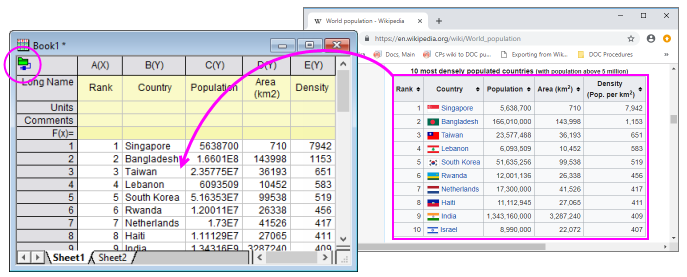

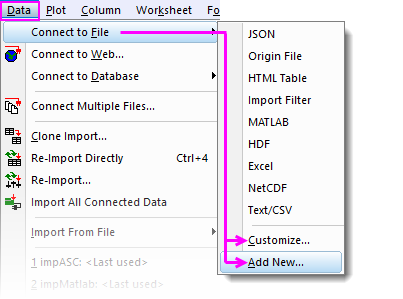
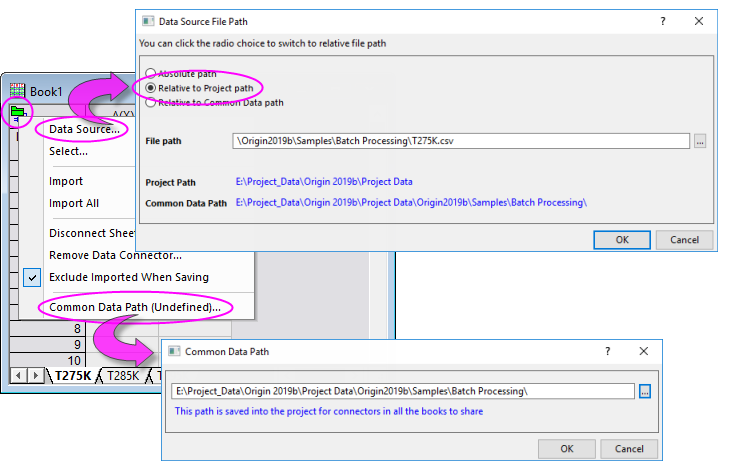





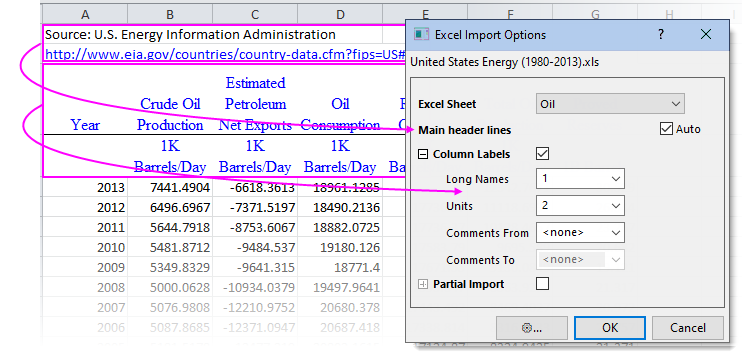
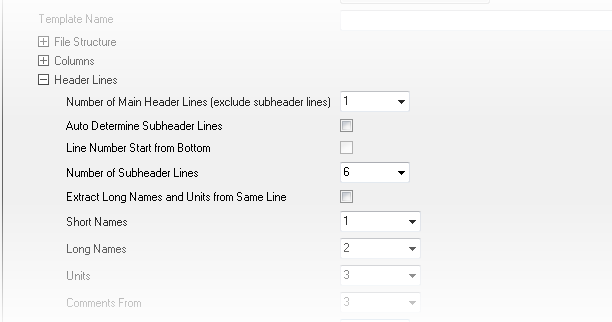

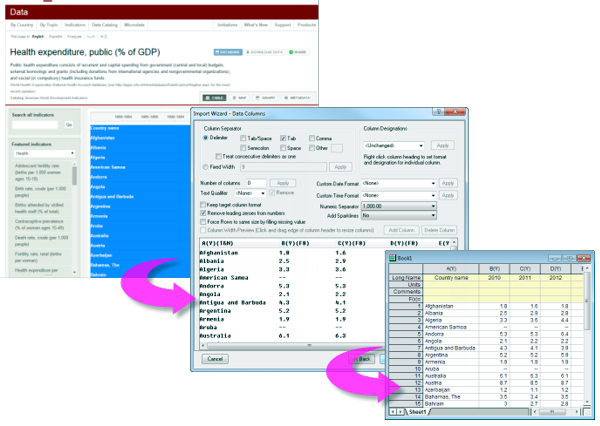
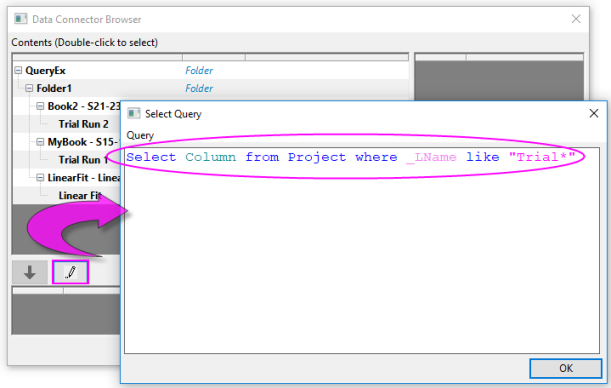


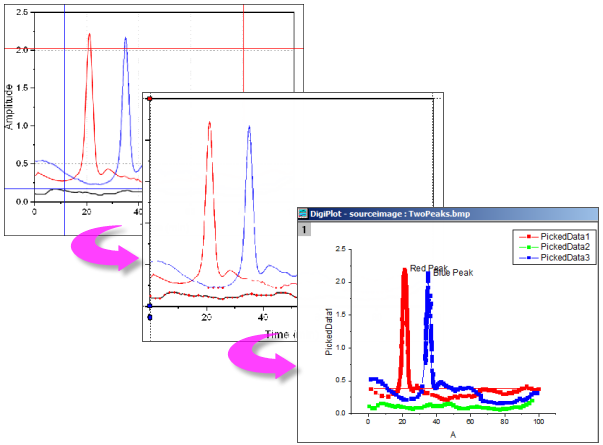


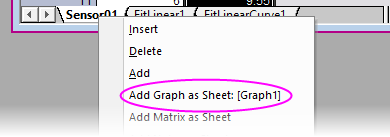
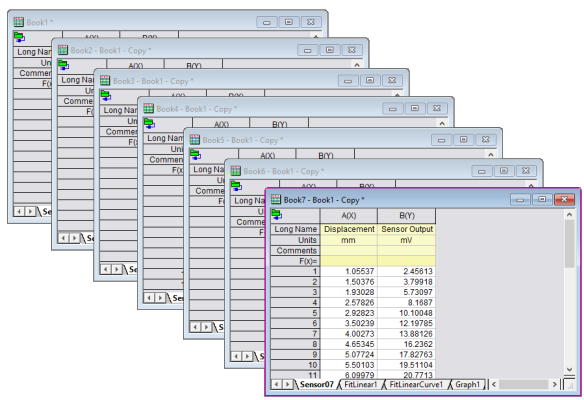
0 Response to "How To Upload .dat Data Eeglab"
Post a Comment